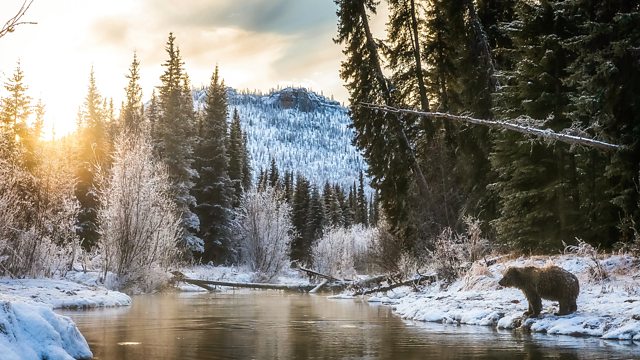Great Rivers episode 3 – Yukon: Remote and wild, the Yukon is a river of haunting beauty and dangerous extremes – a place where the ‘call of the wild’ is still strong. In summer, it is a relentless giant, carving its way 2,000 miles across Canada and Alaska. In winter, -50C temperatures transform it into a river of ice.
Alternative stream
Home to grizzlies, moose and great runs of salmon, the Yukon lies at the heart of a vast northern wilderness. Bears delay their winter hibernation to fish for a final salmon feast, while the frozen river provides a lifeline for lynx and a race track for intrepid dog sledders. From indigenous hunters to gold-prospectors, musk ox to caribou, the Yukon’s natural riches have long sustained people and animals and continue to do so despite its changing fortunes.
Great Rivers episode 3 – Yukon
The Yukon River is a major watercourse of northwestern North America. From its source in British Columbia, Canada, it flows through Canada’s territory of Yukon (itself named after the river). The lower half of the river continues westwards through the U.S. state of Alaska. The river is 3,190 kilometres (1,980 mi) long and empties into the Bering Sea at the Yukon–Kuskokwim Delta. The average flow is 6,400–7,000 m3/s (230,000–250,000 cu ft/s). The total drainage area is 833,000 km2 (321,500 sq mi), of which 323,800 km2 (125,000 sq mi) lies in Canada. The total area is more than 25% larger than Texas or Alberta.
The longest river in Alaska and Yukon, it was one of the principal means of transportation during the 1896–1903 Klondike Gold Rush. A portion of the river in Yukon—”The Thirty Mile” section, from Lake Laberge to the Teslin River—is a national heritage river and a unit of Klondike Gold Rush International Historical Park. Paddle-wheel riverboats continued to ply the river until the 1950s, when the Klondike Highway was completed. After the purchase of Alaska by the United States in 1867, the Alaska Commercial Company acquired the assets of the Russian-American Company and constructed several posts at various locations on the Yukon River.
The Yukon River has had a history of pollution from military installations, dumps, wastewater, and other sources. However, the Environmental Protection Agency does not list the Yukon River among its impaired watersheds, and water-quality data from the U.S. Geological Survey shows relatively good levels of turbidity, metals, and dissolved oxygen. The Yukon and Mackenzie rivers have much higher suspended sediment concentrations than the great Siberian Arctic rivers.




